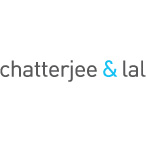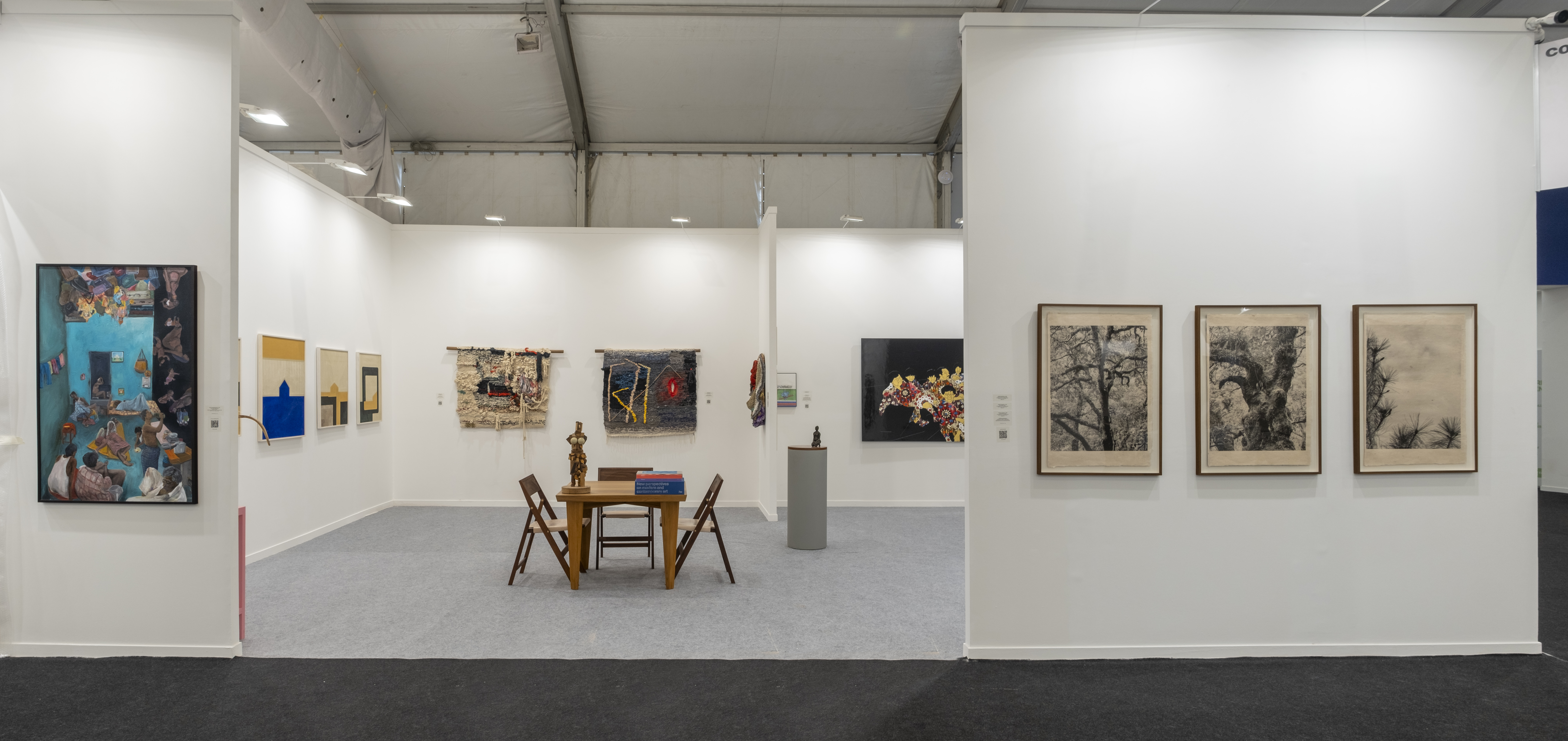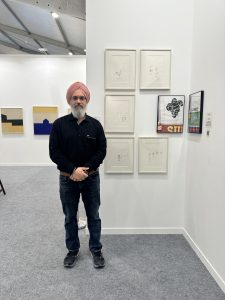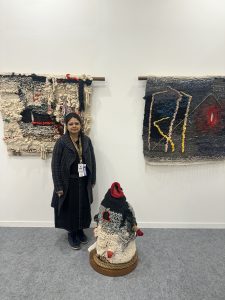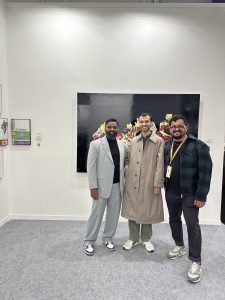Art Fairs > 2024
India Art Fair | New Delhi | 2024
Chatterjee & Lal was a part of India Art Fair 2024 which was held in New Delhi from February 1 – 4.
Install Shots | Chatterjee & Lal
- Gagan Singh
- Moumita Das
- Nihaal Faizal pictured with Mario D’souza and Amshu Chukki
- DLN Reddy’s Family
(L to R: Artists Gagan Singh, Moumita Das, Nihaal Faizal and the family of DLN Reddy with their works displayed at the C&L Booth at IAF 2024)
The booth included works of artists:
Arshi Irshad Ahmadzai
Arshi Irshad Ahmadzai is a Weimar-based artist of Indian origin. Arshi was born in Najibabad and has lived in India and Afghanistan before moving to Germany, where she is currently based. Ranging in scale and medium, Arshi has worked to cover a variety of themes. Critiquing the position, agency and lack of it, of the Muslim woman, Arshi produces work that incorporates words and visuals in a manner that might be reminiscent at times of fragments of ancient texts, and of very personal journals at others. Motifs like the pomegranate, chair, takhti, gardens and heart appear repeatedly in Arshi’s visuals pointing at her interest in the tense threads that connect womanhood, identity, culture, history and power.
Nikhil Chopra
Drawing resides at the heart of Nikhil Chopra’s performance-based practice. Over the last decade he has used diverse unconventional surfaces to bring alive his mark making, including paper, walls, pavements, ceilings, as well as large swathes of cloth and canvas. Landscapes constitute the majority of these works. Often these landscapes are the very same ones into which the artist is about to journey. Amongst many major institutional exhibitions, Nikhil Chopra was included in Documenta 14, 2017; Yinchuan Biennale, China, 2018; The Metropolitan Museum of Art, 2019; San Francisco Museum of Modern Art, 2019.
Moumita Das
Moumita Das’s work is an homage to many histories: to a history of art and abstraction, to the practices and techniques of Indian artisans, especially weavers and dyers, and perhaps also, to domestic labor, which is often omitted from the category of art altogether. Despite these large categorical resonances, Das’ work remains intensely personal. History and personal life mingle as memories and experiences assume an artistic form.
Nihaal Faizal
Nihaal Faizal’s works respond to the copy, the replica, the remake, the gadget, and the gimmick. He is based in Bangalore, India, where he founded Reliable Copy, a publishing house for works, projects, and writing by artists. Previous solo exhibitions include (video art) at Bill’s PC (Fremantle, 2023), ‘Special FX’ at Blueprint12 (New Delhi, 2022), and ‘The Real Taste of India’ at Mumbai Art Room (with Chinar Shah, Mumbai, 2017). Recent group exhibitions include ‘Bare Acts’ at Shrine Empire (New Delhi, 2023), ‘Proposals for a Memorial to Partition’ at 12G (Philadelphia, 2023), ‘How to know what’s really happening’ at Betonhalle in silent green Kulturquartier (Berlin, 2023), and ‘How to reappear: Through the quivering leaves of independent publishing III’ at Kochi- Muziris Biennale (Kochi, 2022-23).
Naveen Kishore
Naveen Kishore’s eye is informed by his deep engagement with theatre photography, a genre he has been practicing since beginning to work in theatre production in the early 1970s. He has extensively documented female impersonators from Manipuri, Bengali and Punjabi theatre practices. His interest in street photography comprises the second main thread of his oeuvre.
Kausik Mukhopadhyay
Kausik Mukhopadhyay’s kinetic and static installations are made by repurposing old electronic items. The artworks are at once whimsical and disturbing. With the artist having devoted much of the last twenty years to teaching, his work has rarely been seen publicly. Kausik Mukhopadhyay has been shown at The Tate Modern, London; National Gallery of Modern Art, India; Serendipity Arts Festival, Goa; and Pittsburgh International Festival of Firsts, Pittsburgh 2018.
Hetain Patel
Hetain Patel’s practice spans a number of different media and is often performative in nature. Identity formation has been central to his concerns since the beginning of his career, more recently this idea has been viewed through the lenses of imitation, language and physical movement. Increasingly Hetain’s work is populated by characters, both fictional and real, in relation to which the artist juxtaposes himself in moments of elision and dissonance.
Sahej Rahal
Sahej Rahal’s body of work is a growing narrative that draws upon mythical beings, and brings them into a dialogue with the present. Within this narrative, these beings perform absurd acts in derelict corners of the city, transforming the spaces into liminal sites of ritual. The temporal act and its residue become primary motifs in his practice. Sahej Rahal’s participation includes Vancouver Biennale 2014; Kochi-Muziris Biennale 2014; Liverpool Biennale 2016; Australian Centre for Contemporary Art, Melbourne 2019; and Gwangju Biennale, South Korea 2020.
DLN Reddy
In a career spanning five decades, Reddy’s creative output spans an enormous range of media including paintings, sculpture and installation. A restless artist by nature, his stylistic reference points were in a constant process of flux. At the same time, a commitment to the human figure, especially the female form, is discernible as a thread connecting his entire career. Reddy was selected for numerous national and international exhibitions, and early on in his career he was invited for a large number of graphics and printmaking exhibitions.
Gagan Singh
Born in 1975, Singh studied fine art in the UK and has exhibited in various group shows including the Sarai Reader 09 at the Devi Art Foundation, Delhi, 2012 – 2013. The content of the work falls into two broad categories, the autobiographical and the erotic. In both cases, humour acts as a point of access through which other issues, often more serious, are explored by the artist.
Rustom Siodia
Rustom Siodia was a painter, illustrator, and essayist. A product of Sir J.J. School of Art and the Royal Academy in London – where he was the first Parsee and perhaps first Indian to be enrolled – he was most active between 1915 and 1939. Although today best remembered for his portraits, his innovative landscapes and historical paintings reveal a singular artistic vision, quite unlike anyone else working at that time in India. He received major commissions at institutions such as the Royal Opera House in Bombay and the Imperial Secretariat (later to become Rashtrapati Bhavan) in New Delhi.
Nityan Unnikrishnan
Nityan Unnikrishnan grew up in Kerala along with its intellectual mileu of a world populated by left leaning filmmakers, painters and academics. He creates paintings from a myriad of sources, both real and imaginary, including elements from his childhood and his working life. He creates a dynamic relationship between the individual self and landscape. These surreal inversions of reality take the viewer to the interior world of the subject and, by default, to the world of the artist himself.
